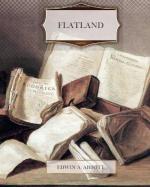
|
| Name: _________________________ | Period: ___________________ |
This test consists of 5 multiple choice questions, 5 short answer questions, and 10 short essay questions.
Multiple Choice Questions
1. Under what name was Flatland originally published?
(a) B. Triangle
(b) A. Square
(c) Edwin Abbott
(d) John Smith
2. What does Hoffman say about the first three dimensions?
(a) They are unstable.
(b) They are stable.
(c) They are temporal.
(d) They are spatial.
3. What happens to a line as it gets closer in Flatland?
(a) It gets larger.
(b) It gets thinner.
(c) It gets thicker.
(d) It gets smaller.
4. What is the editor's defense of the second objection?
(a) That the author was writing his true opinion, and has a right to his opinion.
(b) That the author was pointing out the danger of religion.
(c) That the author was writing as other historians have written.
(d) That the author was defending children through irony.
5. What group showed the most amazing display of color?
(a) The Military
(b) Intellectuals
(c) The Woman
(d) Circles
Short Answer Questions
1. What does the editor say is his second reason for writing the preface?
2. What happened to those who attempted to discover the source of light in Flatland?
3. What does the editor say is his first reason for writing the preface?
4. Who is Pantocyclus?
5. The first law for women is;
Short Essay Questions
1. Explain the basic process of evolution, as described in Chapter 3.
2. What occurred when individuals began to question where light came from?
3. Based on the end of the Preface, what is the author attempting to say about the ruling class of his time?
4. Explain how sight recognition is used in upper classes, and why such a method cannot be used for the lower class.
5. What is Hoffman's belief about the relatability of the characters in the novel?
6. What is the author's primary defense against the idea that A. Square hates women?
7. What happened when the Circles regained power following defeat of the color bill? Please be specific.
8. Explain the overall shape of a woman in Flatland, and why such a shape is detrimental?
9. How is the temper of women useful in ridding society of the most brutal of the Isosceles class?
10. What happens to aristocratic children who fail exams, and as a result, what does the State feel should happen?
|
This section contains 943 words (approx. 4 pages at 300 words per page) |

|




